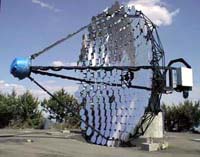Physics and Astronomy
This area deals with the fundamental laws and building blocks of nature and how they interact, the properties and the behavior of matter, and research into space and time and their structures.
innovations-report provides in-depth reports and articles on subjects such as astrophysics, laser technologies, nuclear, quantum, particle and solid-state physics, nanotechnologies, planetary research and findings (Mars, Venus) and developments related to the Hubble Telescope.

Magnetism shapes beauty in the heavens
Using a technique based on the work of the 1902 Nobel Prizewinner, Pieter Zeeman, an international team of astronomers have, for the first time, provided conclusive proof that the magnetic field close to a number of aging stars is 10 to 100 times stronger than that of our own Sun. These observations suggest a solution to the long outstanding problem as to how, at the end of their lives, a perfectly spherical star can give rise to the complex and often far from spherical structure seen in the resultin

A Glimpse of the Young Milky Way
VLT UVES Observes Most Metal-Deficient Star Known [1]
A faint star in the southern Milky Way, designated HE 0107-5240, has been found to consist virtually only of hydrogen and helium. It has the lowest abundance of heavier elements ever observed, only 1/200,000 of that of the Sun – 20 times less than the previous record-holding star.
This is the result of a major ongoing research project by an international team of astronomers [2] . It is based on a decade-lon

Some cosmic rays originate within solar system, researchers find
Researchers have found that a portion of anomalous cosmic rays — charged particles accelerated to enormous energies by the solar wind — results from interactions with dust grains from a belt of comet-sized objects near Pluto’s orbit. These objects make up what is known as the Kuiper Belt, a remnant of the formation of the solar system.
“This novel finding shows how dust in the cosmos may play an important role for producing the most energetic particles known,” says Dr. Nathan S

Experiment could reveal ’extra dimensions’, exotic forces
Physicists have devised a new experiment that will be used in the quest for exotic forces in nature and “additional spatial dimensions.”
The researchers have demonstrated an innovative way to measure a phenomenon known as the Casimir effect – findings that also could have implications for the design of microscopic machines that contain tiny parts on the size scale of nanometers – or billionths of a meter.
The scientists are taking their theoretical findings a step further by

Physicist probes dark, violent side of the universe; studies highest energy photons
In search of cosmic mayhem
A physicist at Washington University in St. Louis working with scientists at the Smithsonian Institution is unveiling the dark, violent side of the universe.
Studying the highest energy photons known to science, Washington University Associate Professor of Physics James H. Buckley, Ph.D., and his colleagues are analyzing bursts of gamma rays released from massive black holes at the center of so-called active galaxies.
Using the Whipple Ob

Gravity waves analysis opens ’completely new sense’
Sometime within the next two years, researchers will detect the first signals of gravity waves — those weak blips from the far edges of the universe passing through our bodies every second. Predicted by Einstein’s theory of general relativity, gravity waves are expected to reveal, ultimately, previously unattainable mysteries of the universe.
Wai-Mo Suen, Ph.D., professor of physics at Washington University in St. Louis is collaborating with researchers nationwide to develop waveform t